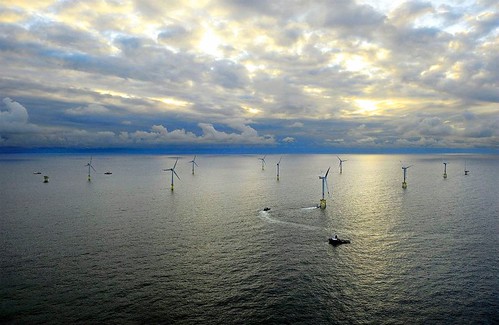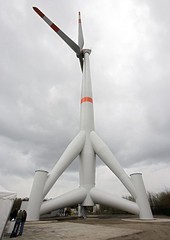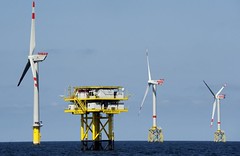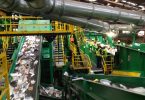
Offshore Windpark Alpha Ventus. Photo DOTI/Matthias Ibeler/ddp
On April 27th, exactly one week after the Deepwater Horizon explosion, Environment Minister Dr. Norbert Röttgen officially inaugurated Alpha Ventus, Germany’s first offshore wind farm 45 kilometers off the coast of the island of Borkum in the North Sea. Built by a consortium of German utility giants EWE, E.ON and Vattenfall Europe, this 250 million Euro project rang in a new era of offshore wind farms that are expected to produce huge amounts of clean energy, not only in Germany but all around Europe.
I happened to be back home in Germany that week, and whether you call it cosmic concurrence or just plain old coincidence, I couldn’t help but marvel at the symbolic significance of a burning oil rig flickering across the TV screen while I was reading and looking at photos of Germany’s First Offshore Wind Farm Going Online in that week’s issue of Der Spiegel.
Having been used to the old ant-like mills a la Altamont Pass, the following paragraph caught my immediate attention:
Twelve wind turbines tower above the icy water, covering an area of roughly four square kilometers (1.5 square miles), or about the size of 500 soccer fields. At a height of 150 meters (492 feet), each turbine is as tall as the Cologne Cathedral and, at 1,000 tons, as heavy as 25 fully loaded semi-trailer trucks.

Prototype of the new Offshore-Windmill Multibrid 5000: Ingo Wagner dpa
It’s true, these are not your mom and dad’s garden variety windmills, these puppies are like little power plants unto themselves. According to the manufacturer, Alpha Ventus will feed at least 220 gigawatt hours of energy into the grid each year, or enough to power 50,000 households. Certainly no reason to write the oil obit, but no chump change either.
The good news is that this is really just the beginning. Many more of these wind farms are going to go into service in the coming months and years, all along German and European coasts, feeding enormous amounts of electricity into the grids on the mainland. In addition to providing unprecedented amounts of power, Alpha Ventus also serves as a study and research project on how to maximize wind power and meet the challenges of building towers almost 500 feet tall and weighing 1,000 tons. This all in rough seas, at least 30 kilometers (19 miles) away from beaches to protect sensitive wetlands and avoid clashes with local residents and the tourism industry.

Alpha Ventus, Photo David Hecker/ddp
While no one technology or source of energy can or should claim to be the exclusive savior in our quest to find alternatives to fossil fuels, offshore wind power has moved beyond symbolic feelgood status and become one of the most promising contenders to be an economically viable source of energy.
Aside from the obvious environmental benefit that a malfunctioning turbine or platform doesn’t annihilate entire ecosystems, windmill technology has come a long way since its early days. You know it’s not just pretty talk when energy companies are investing billions in offshore wind parks. That’s exactly what’s happening in the North Sea, where major international power companies are currently staking out the future of Europe’s energy supply off the coasts of Germany, Belgium, the Netherlands, Ireland and Britain.
Where’s the U.S. in its offshore wind development? A look at the U.S Offshore Wind Collaborative‘s state by state map yields a flurry of terms like potential, roundtable, planner’s workshop, or public forum. In the great state of New York, the status on the development of a 40-turbine wind farm off Jones beach reads: Project tabled over concerns about escalating construction and materials costs. If the U.S. Department of Energy is serious about wind energy generating 20% of the nation’s electricity demand by 2030, we’ve got to light a fire under our representative’s behinds. It’s time to tell Congress why wind works!








Great article: informative, with food for thought and interestingly written! Thank you Sven & keep going. In peace, Rianne
Thanks Rianne. Sometimes some of the more practical and technological advances can be very inspiring and touch us on a deeper level. And vice versa, of course, too.